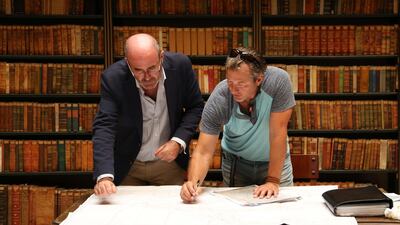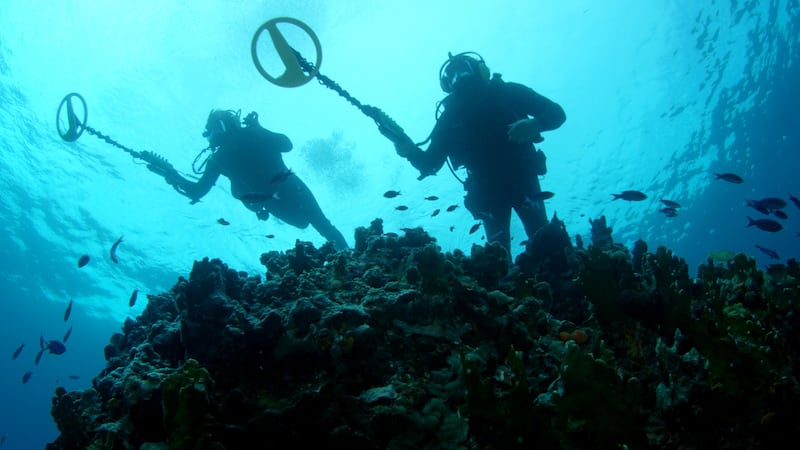At the height of the Cold War in 1963, Nasa astronaut Gordon Cooper found himself on a mission to space, circumnavigating the Earth, looking for nuclear sites. By all accounts, the man who was one of Nasa’s original space pioneers, breaking the record for the longest single-man space flight on a 122-hour mission, found plenty.
And that wasn't all he spotted with his experimental, long-range surveillance equipment. During the course of his 22 orbits of the planet, Cooper noticed a number of anomalies down below – dark patches, in particular in the South Caribbean, which tallied remarkably close to the routes Spanish galleons laden with gold would have taken, to and from their South American and Caribbean colonies.
Cooper concluded that what he had photographed were the shadows of shipwrecks, and this formed the basis of what was to become something of a treasure map from space.
He spent years quietly working on charting and cross-referencing the photographs in a bid to create a definitive map of his findings, but never managed to fully investigate his theories before his death in 2004, after a long battle with Parkinson's disease.
He did, however, manage to reveal his secret to his friend Darrell Miklos, a professional treasure hunter.
This week, viewers can begin to follow Miklos, his team and a camera crew from the Discovery Channel in their exploration of the Atlantic Ocean in search of Cooper's shipwrecks.
Miklos says his interest in treasure hunting came from his father. "He was a professional treasure hunter back in the 1960s and he introduced it to me as a child," he says.
"He took me and my three sisters, and made us walk along the beach, and he said: 'For every black rock that you pick up, I'll give you a quarter'. Well, those black stones were actual silver pieces from the colonial period. And that's how it all started. Once I did that, I was hooked."
He became friends with Cooper through his father too, after Roger Miklos appeared on an American chat show alongside the astronaut in 1978. Their friendship grew following a meeting in the green room after the show.
"Fast-forward to my 30s, I met him in the Bahamas and we flew back to California together. We were working on a project in the Bahamas," Miklos says.
The pair wound up sharing an office. "We shared that office for seven years and became best of friends. And we did expeditions and all sorts of stuff. That's when we started really developing a strong relationship."
Despite their mutual respect for one another, Cooper didn't tell Miklos about his space-age secret until near his death.
"I was totally surprised," Miklos admits. "I was super-excited that he included me in on the secret... I had a million questions, obviously. And we started working through those files, talking about which areas we would like to work on together, because at that point, I became his exploration partner."
After Cooper's death, Miklos didn't jump into the treasure-hunting quest without doing his homework and checking on the validity of the claims.

“I did a lot of research prior to my actually spending lots of money in setting up an expedition, by meeting people in Nasa and making certain contacts with them to prove the viability of there being long-range detection equipment on board,” he says.
Miklos went out to sea to check out some of his friend’s suspected shipwreck sites in advance of the main mission. So far, the astronaut’s suspicions have been accurate.
“I’ve done both [sites] and I’ve managed to prove both were correct,” Miklos says.
“Gordon was right on the money, so to speak. Everything that he pointed out to me on the files, as well as the coordinates on the treasure map from space; actually, each and every one of those that I’ve investigated thus far have been proven to be positive, as far as shipwreck material and historical information.”
Miklos hopes audiences will enjoy following the treasure hunt as much as he enjoyed undertaking it.
“You’re going to places and parts of the Caribbean and everywhere that we go, which probably most people didn’t know even existed... we’re finding shipwreck material of major historical significance and commercial significance in areas that people otherwise would never have known.”
He believes had it not been for Cooper’s research or the treasure map he designed from space, this would have remained the astronaut’s secret. “The story would have ended in his office had he not given it to me,” Miklos says.
If the Caribbean quest proves successful, there’s plenty of scope for further discovery. According to Miklos, Cooper believed he had also found sites around South America and in the Mediterranean and Adriatic. “I think there’s so much more to come. I can’t elaborate on a lot of things, but I can tell you that this story is ongoing and there’s lots of new information that will come out,” Miklos says.
Cooper’s Treasure will premiere on the Discovery Channel tomorrow at 10pm. The first episode shows Miklos diving in the Gulf of Mexico off Campech





